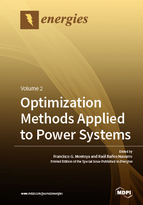Optimization Methods Applied to Power Systems
A special issue of Energies (ISSN 1996-1073). This special issue belongs to the section "F: Electrical Engineering".
Deadline for manuscript submissions: closed (28 February 2019) | Viewed by 140892
Special Issue Editors
Interests: geometric algebra; power quality; power theory; power engineering; optimization techniques
Special Issues, Collections and Topics in MDPI journals
Interests: energy economics; renewable energy; power meters; network analysis; engineering optimization
Special Issues, Collections and Topics in MDPI journals
Special Issue Information
Dear Colleagues,
We are inviting submissions to a Special Issue of Energies Journal on the subject area of “Optimization Methods Applied to Power Systems”. Power systems are made up of extensive complex networks governed by physical laws in which unexpected and uncontrolled events can occur. This complexity has increased considerably in recent years due to the increase in distributed generation associated with increased generation capacity from renewable energy sources. Therefore, the analysis, design and operation of current and future electrical systems require an efficient approach to different problems (like load flow, parameters and position finding, filter designing, fault location, contingency analysis, system restoration after blackout, islanding detection of distributed generations, economic dispatch, unit commitment, etc.). Given the complexity of these problems, the efficient management of electrical systems requires the application of advanced optimization methods that take advantage of the advances of current computers.
The topics of interest in this Special Issue include different optimization methods applied to any field related to power systems, such as conventional and renewable energy generation, distributed generation, transport and distribution of electrical energy, electrical machines and power electronics, intelligent systems, advances in electric mobility, etc. The optimization methods of interest for publication include, but are not limited to:
- Expert Systems
- Artificial Neural Networks
- Fuzzy Logic
- Genetic Algorithms
- Evolutionary Algorithms
- Simulated Annealing
- Tabu Search
- Ant Colony Optimization
- Particle Swarm Optimization
- Multi-objective Optimization
- Parallel Computing
- Linear and Nonlinear Programming
- Integer and Mixed-Integer Programming
- Dynamic Programming
- Interior Point Methods
- Lagrangian Relaxation and Benders Decomposition-based Methods
- General Stochastic Techniques
Prof. Dr. Francisco G. Montoya
Dr. Raúl Baños
Guest Editors
Manuscript Submission Information
Manuscripts should be submitted online at www.mdpi.com by registering and logging in to this website. Once you are registered, click here to go to the submission form. Manuscripts can be submitted until the deadline. All submissions that pass pre-check are peer-reviewed. Accepted papers will be published continuously in the journal (as soon as accepted) and will be listed together on the special issue website. Research articles, review articles as well as short communications are invited. For planned papers, a title and short abstract (about 100 words) can be sent to the Editorial Office for announcement on this website.
Submitted manuscripts should not have been published previously, nor be under consideration for publication elsewhere (except conference proceedings papers). All manuscripts are thoroughly refereed through a single-blind peer-review process. A guide for authors and other relevant information for submission of manuscripts is available on the Instructions for Authors page. Energies is an international peer-reviewed open access semimonthly journal published by MDPI.
Please visit the Instructions for Authors page before submitting a manuscript. The Article Processing Charge (APC) for publication in this open access journal is 2600 CHF (Swiss Francs). Submitted papers should be well formatted and use good English. Authors may use MDPI's English editing service prior to publication or during author revisions.
Keywords
- power systems
- electrical systems
- optimization techniques
- heuristic techniques
- artificial intelligence techniques







